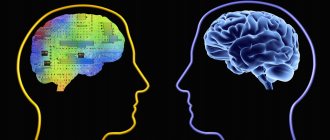Have you ever tried to look at a picture of one color and name another? If you’ve tried it, then most likely you know that it’s quite difficult, but if you haven’t tried it, then try it – you’ll probably be quite surprised by the result. It is even more difficult to read words that mean one color, but are written in another, or to name the color in which the word is written, and not the word itself. Try it yourself (you can practice the Stroop test in the form of a game in our free course on the development of thinking “Neurobitics”):
- RED
- YELLOW
- BLUE
- GREEN
- WHITE
- VIOLET
- PINK
- BLACK
- ORANGE
- GOLDEN
The fact is that it is difficult to distract from the meanings of words, given that from childhood we learn to perceive information in a specific way. By the way, it was not by chance that we decided to conduct a small verbal-color experiment with perception, and the first one was done a very long time ago.
Stroop effect
John Ridley Stroop (March 21, 1897 – September 1, 1973) was an American psychologist and teacher of psychology and theology. He worked in the field of experimental psychology, studied cognitive processes, primarily attention. His article “A Study of Interference in a Verbal Response Series” is one of the most cited publications in the Journal of Experimental Psychology, and various modifications of the Stroop test he created are widely used in the 21st century. At the same time, it is incorrect to name only Stroop as the author of the test. He developed the classic version known today. But the idea of using word-color combinations dates back to the developments of the German psychologist and physiologist Wilhelm Wundt and his student, the American psychologist James Cattell. Cattell would later become the founder of testing methods, one of the first specialists in psychometrics and psychodiagnostics.
It’s this classic test that we’ll talk about. The standard execution involved offering subjects three cards:
- The names of colors were written on the first card: yellow, blue, red and others; the words themselves were written in black.
- The second card had multi-colored squares without text content: yellow square, red square, blue square and others.
- The third card showed a so-called word-color mix, in which the words did not match the colors in which they were written. For example, “blue” was written in yellow, “red” in green, etc. There was no pattern to the mix, i.e. any word could correspond to any color.
Based on this, the test subject was presented with four options for tasks:
- Read the words written on the first card;
- Name all the colors of the squares shown on the second card;
- Read the words on the third card, provided that the color of the ink is to be ignored;
- Name the colors of the words written on the third card, provided that the meaning of the words must be ignored.
During the experiment, the researchers noticed that the fourth task was the most difficult for the test takers, but the third caused the least difficulties.
Material and methods
12 healthy volunteers were examined, 10 of them were women, median age 57 years [1st and 3rd quartiles 55.5; 59.5]. All subjects underwent two fMRIs with a block design with an interval of at least 48 hours. Each task consisted of alternately presented 4 active blocks and 4 rest blocks lasting 30 s each (total 8 blocks). In the first study, periods of rest - fixating the gaze on a cross displayed in the center of the screen - alternated with periods of the Stroop test, in which images with the name of a color were projected onto the patient's screen. The color of the font coincided or did not coincide with the meaning of the word (1.5 s/image), the alternation of images was random. The patient was tasked with silently responding with the word “yes” if the color of the font matched the meaning. In the second fMRI study, periods of rest, during which the subject lay quietly in the scanner with his eyes closed, alternated with periods of counting. After the voice command, the subject mentally built up a number series from 1 onwards, omitting numbers that are multiples of 3. In both cases, training in performing the task was carried out before the study.
Neuroimaging examination was carried out on a Siemens MAGNETOM Verio 3 Tesla magnetic resonance imaging scanner and included a study of the brain in T2-spin echo modes in the axial projection to assess the substance of the brain: repetition time (TR - repetition time) 4000 ms, echo time (TE - time echo ) 118 ms, slice thickness 5 mm, interslice interval 1.5 mm; duration 2 min 2 s; T2*-gradient echo in axial projection to obtain functional MRI data (TR 3000 ms, TE 30 ms; slice thickness 3.0 mm; duration 4 min 08 s); 3D T1_mpr in sagittal projection to obtain isotropic anatomical data for the purpose of subsequent superimposition of functional data (TR 1900 ms, TE 2.5 ms; slice thickness 1.0 mm; interslice interval 1 mm; duration 4 min 16 s).
All subjects signed informed consent for the examination. The study protocol was approved by the local ethics committee of the Federal State Budgetary Institution NCN.
The SPM8 (https://www.fil.ion.ucl.ac.uk/spm) and CONN17 software packages were used to process fMRI data. a [26] based on MATLAB 2013a (8.1.0.604).
A standard data preprocessing protocol was used separately for each subject for each test: motion correction, coregistration of functional and anatomical data, normalization of data relative to the standard MNI (Montreal Neurological Institute) coordinate space [27] and smoothing [28], followed by group analysis.
Statistical parametric maps were generated based on voxel-by-voxel comparisons using a general linear model [29]. For each subject, data on activation zones were obtained in the form of color maps superimposed on anatomical data, as well as in digital format indicating the level of statistical significance of the activation zone, its volume and coordinates of the cluster center in the MNI stereotaxic space [27]. Subsequent analysis of the group was carried out using a one-sample Student's test (one-samplet-test) with a threshold of statistical significance p
≤0.05 without correction for multiple comparisons, T>4.5.
For a comparative analysis of activation when using different paradigms, a two-sample Student's t test for dependent samples (paired t-test) was used with a threshold of statistical significance p
≤0.05 without correction for multiple comparisons, T>4.5. Subsequently, xjView 9.0 (Human Neuroimaging Lab, Baylor College of Medicine) based on SPM8 was used to localize areas of interest using Brodmann fields, view and present the obtained data.
To study functional connections in the CONN 17.a program, Pearson correlation analysis was carried out followed by the use of Fisher's transformation for each subject, and then group analysis was also carried out using a one-sample Student's test (one-sample-test) with a threshold of statistical significance p
<0.005 corrected for multiple comparisons (the effect of multiple comparisons was assessed by the FDR (False Discovery Rate).
Information overlay
The phenomenon characterized by the fact that one type of information is superimposed on another is called in science the term “interference”. But what is more interesting is that in the first place for human perception is the text, and not the color component, which, in fact, explains the difficulties in naming the color.
And here the very trap that we all know as cognitive distortion begins to operate. In other words, the very process of a person uttering textual data includes its meaning, thereby initiating a “system failure” and distorting human perception. Naturally, in the end, the person completes the task, and he overcomes the difficulties that arise before him, but this requires some mental effort and time.
What gives?
Initially, the Stroop test was widely used to diagnose attention problems, depressive disorders and Parkinson's disease. We have included the Stroop task in our children's training system due to its proven rehabilitation practice and effectiveness in developing cognitive abilities. Regular training and the results of its completion will help determine the dynamics of the development of the child’s cognitive sphere. The child will learn to better concentrate attention not on abstract perception, but to look “into the essence” of the problem, to look for factual rather than theoretical meaning. Improving voluntary attention will increase productivity in learning and ensure optimal decision-making in various situations.
What's the point?
Speech represents one of the greatest “discoveries” of humanity. Scientists believe that this fact is decisive when we talk about isolating the human brain from the animal world, because it is most directly interconnected with consciousness and thinking.
After oral speech appeared, written language appeared, and they should be considered to be two sides of the same “coin”. More specifically, speech formation and recognition are controlled by specific parts of the brain that do not coincide with the parts responsible for color recognition. And it is at this stage, when a person pronounces a color, that he encounters the most serious obstacles in the experiment, because he is already automatically drawn to read and pronounce what is written.
Scope of use
It is used not only as a simulator, but also helps to diagnose the presence of stress in an individual. It is often even used to detect depression and Parkinson's disease.
Difficulties concentrating most often arise due to disturbances in the emotional sphere. Which is quite logical, if a person is worried about something, he will concentrate on his problem and internal experiences. Events occurring outside recede into the background.
And even when trying to get involved in doing work, thoughts that are a higher priority at the moment will reduce the effectiveness of actions. Try this experiment yourself. Arm yourself with a stopwatch and record the time it takes you to cope with any set of multi-colored words indicated incorrectly. Then repeat the steps only when you are tired or experiencing strong emotional experiences. The result will vary significantly.
Do you know what else this effect was actively used for? Previously, counterintelligence in America used this test to detect spies from the USSR. No matter how hard they tried to hide their true biography by feigning ignorance of the Russian language, the Stroop effect made itself felt, revealing them as liars.
The research procedure was slightly modified. The text was written using the English alphabet, with one caveat - the words themselves were Russian. The Soviet spies unknowingly coped with the task quite quickly, especially in comparison with the American suspects, who completely did not understand the meaning of what was written on the sheet, naming only the colors provided.
Changes in terms and conditions
Despite all of the above, the presented effect can be observed only when, under “color” words, people are offered only the names of colors, and in a language familiar to them.
So what will happen if we change the conditions of the experiment and invite its participants to pronounce the colors of other words, i.e. no color names? And this is what will happen - they will complete the task quite easily, without any difficulties.
So, in order to “confuse” a person and cause that same cognitive dissonance, using the superimposition of information, the experimenter must simultaneously evoke two color images in him, the first of which must activate memory through the meaning of the word and update the image of color using the written concept, and the second image is created already directly by the color itself. Those. if for any reason a person ceases to perceive the meaning of what is written, or the word simply does not create a color image in him, “confusion” will not be achieved and, therefore, the Stroop effect will not occur.
Method of word-color interference
The technique is also known as the Stroop Test, Stroop Task. The test is designed to diagnose the cognitive style of flexibility/rigidity of cognitive control.
Cognitive style characterizes the degree of subjective difficulty in changing methods of processing information in a situation of cognitive conflict. Rigid control indicates difficulties in the transition from verbal to sensory-perceptual functions due to their low degree of automation, while flexible control indicates the relative ease of such a transition due to their high degree of automation. The Stroop test in its classic version included three stimulus cards:
- a map of words printed in black ink;
- color card (in the form of squares);
- a map of words printed in fonts of colors that do not correspond to their meanings.
In this case, 5 colors and words were used: “red”, “blue”, “green”, “brown” and “purple”. The words and colors on the white cards were presented in a matrix of 10 rows and 10 columns. Each of the 5 colors (or words) appeared twice in each row and in each column, but they were not repeated in a row and did not form any regular sequences. Words with meanings that did not match the font were printed the same number of times in each of the other 4 colors (eg, the word “red” was printed the same number of times in blue, green, brown, and purple).
In accordance with this stimulus material, the subjects were offered the following tasks:
- reading the names of colors printed in black font (CHNTch);
- naming colors (NC);
- reading color names, where the font color differs from the meaning of the word (CHNCo);
- naming the color of a word, where the font color differs from the meaning of the word (NCSo).
Instructions: the subject must name the font colors out loud or read the words on the map line by line from left to right as quickly as possible and without errors. If an error occurred, the subject corrected it independently, if he noticed, or after instructions from the experimenter.
The indicator of the effectiveness of the task was the average value (for the group of subjects) of the time of playing aloud all the stimuli on the map (of which there were usually 100): t(CNCh), t(NC), t(CNCo) and t(NCCo).
12 pp., 5976 words
Didactic capabilities of information and communication technologies...
... expressive (expression), conveying a certain feeling and evoking corresponding emotions (trinity of color). Color is naturally superimposed on the image, so these are the expressive characteristics, such as warm (... literature to identify and justify the need to identify the peculiarities of preschoolers’ acquaintance with color. Hypothesis - if we identify the didactic capabilities of ICT, then it will be...
A significant interference was discovered by incongruent meanings of words on the naming of the font colors of these words (t(NCCo)>>t(NC)) - it is now called the Stroop effect
(Stroop Effect).
The interference effect of font colors on word reading, on the contrary, was insignificant (t(CNCo) - t(CNCch)).
Stroop also noted that multi-day training in naming word font colors reduced the interference effect of word meaning on font color, consistent with the learning curve, but increased the interference effect of font color on word meaning.
How to synchronize different areas of the brain?
But is it possible to make the parts of the brain that compete with each other when performing a task work together?
In a sense, this question can be answered positively. The fact is that if you do the fourth task of the experiment many times, i.e. naming colors that do not correspond to words, the speed of correct execution will increase.
However, there is information that after a certain period of time, color begins to dominate and take all the person’s attention to itself, which affects the speed of completing the opposite - the third task. But there is no need to worry about this, because, again, after some time the balance is restored, and the person becomes able to switch faster each time.
The meaning and application of the Stroop effect
Quite a long time has passed since the Stroop experiment was first conducted, and researchers had an excellent opportunity to look at it from completely different angles. They compared the results of people of different mental and physiological states, ages and genders who took this test, as a result of which they were able to discover certain patterns.
We will not present the rather voluminous results of scientists’ research or their different interpretations, because An entire scientific work could be devoted to this. But we still consider it necessary to note that the Stroop effect turned out to be a very ambiguous phenomenon, because involves a considerable number of cognitive mechanisms.
Scientists pay great attention to the level of automation of some simple processes, such as, for example, reading words. It is likely that a person does not even understand the essence of the text when he makes a mistake and pronounces a word instead of saying a color. It turns out that in order to describe the Stroop effect as objectively as possible, all cognitive processes must be considered as a whole, and this is not an easy task.
Taking into account also the multidimensionality of the effect we are considering, the area in which it can be applied is quite extensive. Currently, it is used as a basis in many simulators and tests that set themselves a variety of goals and are aimed at solving problems of various types. For example, in certain situations, simulators and tests may be aimed at tracking the psychophysical state of the subjects, and in other situations, at tracking the relative degree of their attention.
With the rise in popularity of brain games, the Stroop effect has been used as the basis for cognitive mobility trainers. Specialists using it help people learn to quickly switch from performing one function to performing another, using different parts of the brain in order of priority, thereby increasing its adaptability and ensuring more effective performance of tasks of a different nature. In addition, solving test problems requires attentiveness and involves memory. True, in this regard, everything is not so simple, because there is not yet much evidence of the positive effect of such training on the brain abilities of a healthy person. But if you are striving to develop cognitive processes, then an exercise based on the Stroop test can be considered as one of the exercise options. They are included in our free course “ Neuroscience: Brain Training and Development ”, join us.
Modified Online Stroop Test
For those who want to check whether and how the Stroop effect is reflected in it, we have compiled a corresponding test. Our version differs from the original experiment and is modified in such a way as to be indicative when passing it online. Like all our tests, it is free and available to take without registration.
The test consists of two parts
and includes a total of
30 questions
.
The instructions for both parts of the Stroop test are the same: try to answer as quickly as possible. The first part
(10 questions) is a test for warming up.
Let's say in advance that here the actual and read colors will match. The second part
(20 questions) uses the Stroop effect. Compare the accuracy and completion times of both parts.










